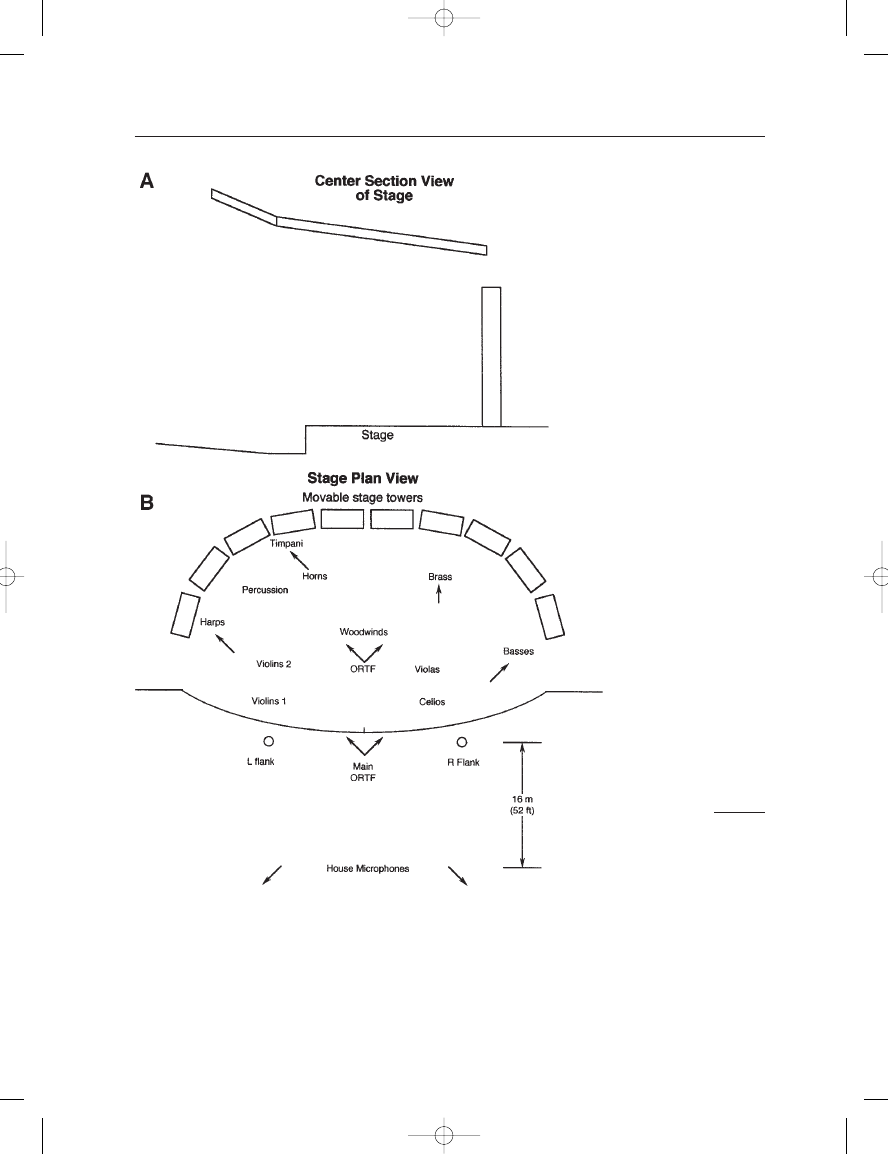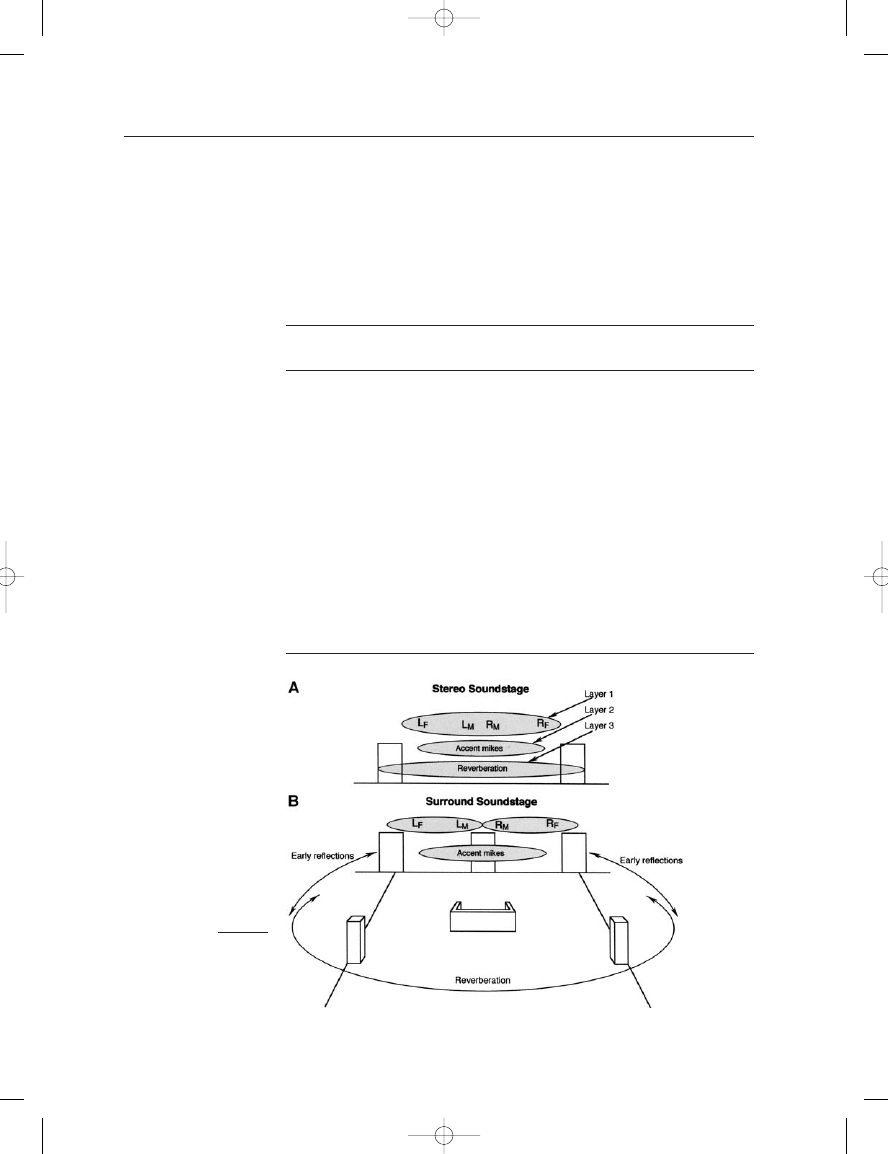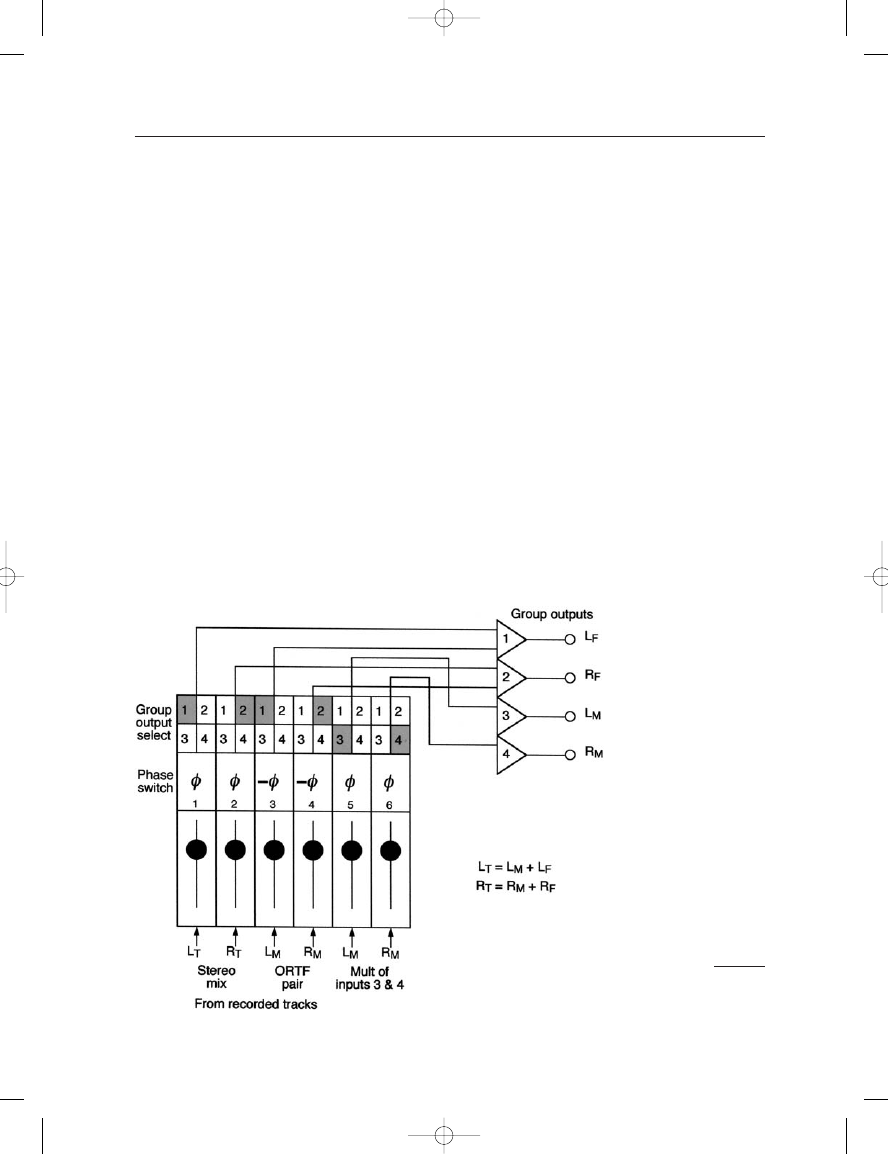ВУЗ: Казахская Национальная Академия Искусств им. Т. Жургенова
Категория: Книга
Дисциплина: Не указана
Добавлен: 03.02.2019
Просмотров: 17269
Скачиваний: 51

orchestra will comprise another layer, and the house microphones,
which convey only reverberation and ambience, will comprise yet
another layer. Normally, if level changes are made in postproduc-
tion, the entire layer will be altered as a unit in order to avoid any
skewing of the sound stage. During the recording process however
individual microphones, or microphone pairs, may be altered on a
running basis as dictated by musical requirements.
5. Track assignments and allocation: When using fewer recording
tracks than there are microphones, informed decisions must be
made regarding which microphones to combine when laying down
the initial tracks. In general the decision is made to subdivide the
recorded elements into basic pre-mixed tracks, or stems, which can
be more easily manipulated during postproduction. Since all of the
works recorded here were to be released first in stereo, a decision
was made to aim for a finished live-to-stereo mix on tracks 1 and 2,
while ensuring that the remaining stems yielded enough flexibility
for creating surround mixes as well as for making minor adjust-
ments in the stereo mix itself. While all eight tracks were edited at
the same time, the stereo tracks were used as as the basic guide for
all edit decisions.
“MARCH TO THE SCAFFOLD,” FROM SYMPHONIE
FANTASTIQUE BY HECTOR BERLIOZ
The recording venue was the New Jersey Performing Arts Center, a 2500-
seat hall with a midrange reverberation time of about 2.3 s. Zdenek Macal
conducted the New Jersey Symphony Orchestra. Diagrams of the stage
layout are given in Figure 16–1, showing positions of the microphones.
The recording was made over three evenings with audience present and
was to be used for both stereo CD production and release in surround
sound. The direct-to-stereo mix was monitored at the sessions and fed
directly to channels 1 and 2 of the six-channel recorder (20-bit/48 k
sampling). Details of microphone deployment are shown in Table 16–1.
Note the use of only two omnidirectional microphones in the setup.
This is in keeping with the principle stated in the chapter on classical
recording in which the main ORTF pair and its associated flanking omnis
provide the basis of the pickup. All other microphones are secondary to
the main four and are intended for subtle heightening of instrumental and
sectional presence and balance. As such, these microphones function best
with the side and back rejection that the cardioid pattern offers.
The accent microphones were all fed, in varying amounts, to a digital
reverberation side chain whose parameters were adjusted to match those
of the hall itself. The stereo returns from the reverberation generator
were panned left and right into the overall stereo mix. The house micro-
phones were aimed at the upper back corners of the hall to minimize
pickup of direct sound from the stage.
16: Surround Recording Case Studies
273
Earg_16.qxd 14/9/04 2:58 PM Page 273

The major components of the stereo soundstage are shown in
Figure 16–2A. In creating the surround soundstage, it was necessary to
“demix” the main ORTF pair from the stereo array and re-pan them into
the frontal sound loudspeaker array as shown in Figure 16–2B. This was
done using a technique known as subtractive mixing, which can be
THE MICROPHONE BOOK
274
FIGURE 16–1
Stage and microphone
layout for “March to the
Scaffold:” center section
view (A); plan view (B).
Earg_16.qxd 14/9/04 2:58 PM Page 274

explained as follows:
Let the main array consist of the following four components:
L
T
L
F
gL
M
R
T
R
F
gR
M
,
where L
F
and R
F
are the outputs of the left and right flanking micro-
phones, and L
M
and R
M
are the outputs of the left and right main ORTF
16: Surround Recording Case Studies
275
TABLE 16–1
Microphone Deployment for “March to the Scaffold”
Position
Description
Stereo Mic
height
Track
panning
assignment
Major components
Stereo mix left
Track 1
Stereo mix right
Track 2
L flank
omni
left
3.5 m (12 ft)
L ORTF
cardioid
left
3.5 m (12 ft)
Track 3
R ORTF
cardioid
right
3.5 m (12 ft)
Track 4
R flank
omni
right
3.5 m (12 ft)
L house
cardioid
left
4 m (13.3 ft)
Track 5
R house
cardioid
right
4 m (13.3 ft)
Track 6
Accent microphones (these appear only in the stereo mix)
L woodwinds
cardioid
half-left
3.5 m (12 ft)
R woodwinds
cardioid
half-right
3.5 m (12 ft)
Harps
cardioid
left
1 m (40 in)
Timpani
cardioid
half-left
2 m (80 in)
Brass
cardioid
half-right
3 m (10 ft)
Basses (1st stand)
cardioid
right
2 m (80 in)
FIGURE 16–2
Target recorded
soundstages for “March to
the Scaffold:” stereo (A);
surround sound (B).
Earg_16.qxd 14/9/04 2:58 PM Page 275

microphones. The symbol g represents a gain factor for the two ORTF
signals, and it is carried over into the signals recorded on tracks 3 and 4
of the digital recorder.
The next step is to subtract the ORTF pair from L
T
and R
T
. This can
be done because the value of g is the same in tracks 1 and 2 as it is in
tracks 3 and 4; the result is:
L
T
L
F
gL
M
gL
M
L
F
R
T
R
F
gR
M
gR
M
R
F
Having “stripped out” the ORTF pair from the left and right frontal
channels of the surround array, we are free to reposition those signals
anywhere in the array we wish. The usual approach is to reintroduce
them by panning L
M
slightly left of the center channel and R
M
slightly
right of the center channel, as shown in Figure 16–2B. As a matter of
practicality, it is possible to carry out subtractive mixing on any console
that has phase reversal stages in each input strip and the facility for
patching and multing various signals. With practice, the process can be
easily carried out by ear, listening for the “null zone” as you alternately
raise and lower the level of the antiphase components.
A functional view of the subtractive mixing process is shown in a
basic form in Figure 16–3. Here, four tracks have been recorded: a
stereo mix (L
T
and R
T
) on tracks 1 and 2, along with the main ORTF
THE MICROPHONE BOOK
276
FIGURE 16–3
Functional view of the
subtractive mixing process.
Earg_16.qxd 14/9/04 2:58 PM Page 276

pair (L
M
and R
M
). Through subtractive mixing we want to separate the
flanking microphone signals (L
F
and R
F
) from the stereo mix. This is
accomplished by feeding the ORTF pair into faders three and four in
antiphase. When these are then fed into Groups 1 and 2, the L
M
and R
M
signals will be canceled, leaving only L
F
and R
F
at the outputs of Groups
1 and 2. For the cancellations to be complete the levels must be matched.
This may be done by adding test signals at the head of all recorded tracks
before the session begins, ensuring that all gain settings downstream
from the faders are fixed. With a little practice, you can approximate this
condition by raising and lowering the phase-inverted faders through the
null region and then isolating the actual null position by ear.
Having adjusted the frontal array as discussed above, we then move
on to the requirements of the rear channels. In this recording, the distance
of the house microphones from the main array resulted in a relative delay
of about 44 ms, which is too great by about 20 ms. This value was com-
pensated for on the virtual console of the digital editing system by delay-
ing all signals other than the house microphones, producing a net time
onset of reverberation of 24 ms that was within normal bounds for good
surround performance. The final step was to re-introduce signals from
the main ORTF pair into the back channels to simulate added early
reflections from the sides. To do this, the outputs of L
M
and R
M
were
high-passed at about 200 Hz, delayed about 20 ms, reduced in level and
fed respectively to the left-rear and right-rear channels.
1812 OVERTURE BY PYOTR TCHAIKOWSKY
(CHORAL ARRANGEMENT BY IGOR BUKETOFF)
The recording venue was McDermott Hall in the Meyerson Symphony
Center, Dallas, TX. Andrew Litton conducted the Dallas Symphony
Orchestra and Chorus. As before, the recording was intended for both
stereo and surround sound release. The recorded track assignment was
composed of: stereo mix (tracks 1 and 2), main pair (tracks 3 and 4),
flanking pair (tracks 5 and 6) and house pair (tracks 7 and 8). Figure 16–4
shows stage and microphone layouts. The composite stereo monitor mix
was assigned to channels 1 and 2 of the digital recorder. Details of micro-
phone deployment are shown in Table 16–2.
The basic pickup is very much like that of the previous example. The
use of omnidirectional microphones for chorus pickup is a judgemental
choice; the broad omni pattern ensures that more members of the ensem-
ble will be covered than if cardioids were used. A drawback here is the
increased leakage of brass and percussion (back of the orchestra) into the
chorus microphones, a problem that required carefully planned gain
adjustments during the sessions.
In the a capella choral opening of the work, the flanking micro-
phones were panned to the rear loudspeakers, giving the impression of a
chorus placed at the back of the hall. As the introduction progressed,
16: Surround Recording Case Studies
277
Earg_16.qxd 14/9/04 2:58 PM Page 277